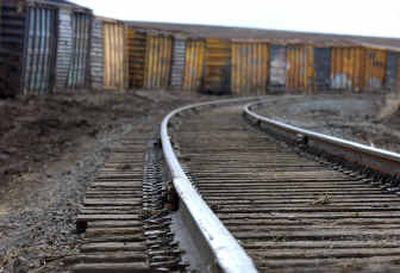A way of life being derailed

First there was the labored breath of a locomotive rolling past Art Mahn’s home, then the iron clap of boxcars derailing.
A curtain of dust drew dark over the 81-year-old’s farm north of Freeman, followed by silence. It was as if someone paused the soundtrack of Mahn’s life. The pulsating roar of the Union Pacific train to St. Maries, Idaho, and the endless drone of traffic on State Highway 27, both a few paces from his doorstep, were gone.
“We were in the shop, as far as that goes. All at once, we heard a bunch of iron hitting together,” Mahn said. “It was the sound of the wheels coming off the boxcars. Then it got quiet.”
The derailment, three weeks ago, was the second in a week for an aging short rail line well traveled by iron horses for more than a century. Consider it a bloodline pulsing with lumber from the mills in St. Maries and, once upon a time, grain from every small-town elevator between there and Spokane Valley.
These days, the iron horses move more like old gray mares. The quality of the track has declined, as have the train trips, which once numbered several daily and now average three a week. The rails aren’t considered safe beyond 25 mph. Locals say the lumbering freight cars seldom test the speed limit.
The railroad isn’t ready to abandon the tracks, said John Bromley of Union Pacific. The lumber run to St. Maries is viable and there are smaller pickups and deliveries along the way, but the profits don’t support major repairs to the track. Many of the towns along the route, some of which took their first breaths from the iron lungs of 1880s steam engines operated by the Great Northern and Milwaukee railroads, no longer use the tracks.
In Rockford, a few miles south of Mahn’s farm, semitrucks shoulder the grain loads once carried by trains. Cheaper freight costs, combined with occupational dangers of rail-side elevators, lured farmers to trucks long ago, said Vern Records, who manages the local Cenex. Farmers now get their fertilizer by train, but only seasonally.
“No, we don’t depend on it. We don’t ship grain on it. It’s too expensive,” Records said. “The fall protection for guys working the elevator isn’t worth it.”
The earth-shaking sound of trains, once the lead instrument in the soundtrack of rural lives is now mere background noise for the moan of rubber on asphalt.
The Evergreen State had 5,000 miles of railroad 50 years ago and now has 3,100, according to the Washington state Department of Transportation.
Mahn remembers when times were different.
In the 1930s, his family loaded their equipment onto a freight train and moved to the Spokane Valley from the arid high plains of Wilsall, Mont., where their crops had been hailed out two years in a row.
The older Mahn kids traveled in boxcars and tended stock.
Mahn and the others took a passenger train, the Hiawatha line, right past the land where he now farms.
In the late 1960s, Mahn took a train to Detroit to pick out a new, two-door Plymouth.
Neither the trip of his youth or that of his middle age are now possible, at least not on the line running by his home.
And the trains now rolling by Mahn’s house occasionally spark fires as the hot metal waste from train brakes meets the farmer’s dry crops.
The fires used to be rare because workers riding in the caboose would notify the engineer of stray sparks.
But these days, the cabooses are gone, and no one is looking back, not the train, not the towns, and the pulse is growing faint.